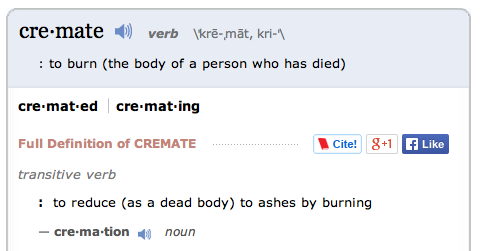 I write this with the greatest of disappointment. As a former CANA (Cremation Association of North America) member for many years, I’m discouraged by the organization having allowed a redefinition of “cremation” to sometimes not include fire.
I write this with the greatest of disappointment. As a former CANA (Cremation Association of North America) member for many years, I’m discouraged by the organization having allowed a redefinition of “cremation” to sometimes not include fire.
Come on CANA members, really – why are you not up in arms about this? Going in opposition to common knowledge tarnishes a reputation, calling into question an organization.
Before we take a look at CANA’s revised definition, let’s revisit cremation as we all know it (well except CANA). When we think of cremation, we think of fire – and yes, flames! First we’ll take a look at Merriam-Webster’s definition via a screen shot:
Hmm yes it clearly says “burning.” Now we’ll check out Wikipedia: “Cremation is the use of high-temperature burning, vaporization, and oxidation…” plus one of the many images of fire illustrating cremation Wikipedia provides. This image below sure looks like some seriously hot flames to me!
I’m more than a little surprised at an attempt at a new definition. Let’s face it, cremation is not new. The first known example of cremated remains dates back 40,000 to 68,000 years ago to Mungo man, where 3 cremated bodies were found in Australia. Cremation was practiced by most early civilizations—many of whom transitioned over time to burial away from paganism. India and Nepal are historically known for their open-air pyres extending into our modern age.
OK now let’s visit the CANA site (cremationassociation.org) and click on the menu “What is Cremation?” and here’s the answer:
“People generally understand what the term cremation means. When we are asked for a detailed definition, however, we tend to hesitate while searching for appropriate words. A suggested definition of cremation is the: “The mechanical and/or thermal or other dissolution process that reduces human remains to bone fragments.” Cremation includes the processing and usually includes the pulverization of the bone fragments.
This definition covers a variety of technologies that may be applied in order to achieve reduction to bone fragments, including traditional flame-based cremation, calcination and alkaline hydrolysis.” – CANA
(note: the definition has been changed again since this post was written)
Yes we do “understand what the term means” and why exactly is CANA “hesitating” and “suggesting” a new one? Puzzling?
Why would they redefine cremation you ask? The clue is in the last words “alkaline hydrolysis.” It’s a new form of disposition with no fire whatsoever as part of the process. It seems they are folding alkaline hydrolysis into the organization. Sure, that’s OK, but here’s my suggestion – a rethink on the organization’s name instead. It’s certainly common for organizations to change names as they morph and transition forward over time.
Meanwhile CANA members and our SevenPonds readers take serious note of this and voice your opinions! So please let us hear from you – just what are your thoughts?
SevenPonds explores cremation and other dispositions:
- Alkaline hydrolysis: Green Burial or Scientific Nightmare? A new disposition method liquefies the body, preserves the environment and horrifies funeral consumers.
- Love and Death Carried By Fire: Is cremation the new American way?
- Why Traditional Coffins Are Going Under: My cameo visit to Aurora Casket Company

 Since When Does Cremation Not Include Fire?
Since When Does Cremation Not Include Fire?




 Sara Williams Fights for Affordable Funeral Options
Sara Williams Fights for Affordable Funeral Options
 Dying Inmates’ End-of-Life Choices Are Routinely Ignored
Dying Inmates’ End-of-Life Choices Are Routinely Ignored
 “Dying for Sex,” Starring Michelle Williams and Jenny Slate
“Dying for Sex,” Starring Michelle Williams and Jenny Slate














